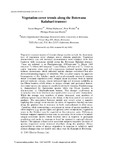Please use this identifier to cite or link to this item:
http://hdl.handle.net/10311/175| Title: | Vegetation cover trends along the Botswana Kalahari transect |
| Authors: | Ringrose, S. Matheson, W. Wolski, P. Huntsman-Mapila, P. |
| Keywords: | Kalahari transects Vegetative responses SAFARI2000 sites Unique ecosystem factors |
| Issue Date: | 2003 |
| Publisher: | Elsevier; www.elsevier.com/locate/jaridenv |
| Citation: | Ringrose, S. et al (2003) Vegetation cover trends along the Botswana Kalahari transect, Journal of Arid Environments 54, pp. 297-317 |
| Abstract: | Vegetative response aspects of climate change studies include the determination of vegetation cover changes across climatic gradients. Vegetation characteristics and soil moisture measurements were obtained from four locations with decreasing rainfall along the Botswana Kalahari transect. These are referred to as Pandamatenga, (698mmyear_1), Maun (460 mmyear_1), Okwa (407 mmyear_1) and Tshane (365 mmyear_1). Trends in major vegetative cover and soil components included species types and richness assessments which reflected certain changes southward but also showed interesting degrees of variability. This occurred despite the apparent homogeneity of the Kalahari sands and predominantly semi-arid savanna shrubâ woodland vegetation cover. Despite linear decreases, both in rainfall and soil moisture content, results indicated high soil moisture variability at the Okwa location which relates to unique climatic and geological factors. Also many species are unique to specific locations for instance Pandametanga is characterized by Zambesian species while the Maun location is characterized by Colophosphermum mopane. This changes southwards as Acacias become more dominant and significantly co-occur with Grewia flava. While the average total numbers of plants decreased, total numbers of different species varied little from the wetter to the drier end of the moisture gradient. The association between rainfall and woody cover is negative implying that canopy cover extents (in terms of vegetation density) increase along the gradient due to increases in bush encroachment in drier areas. Therefore, while representing a continuum in terms of species numbers, in other respects (e.g. species types and ground cover components) vegetation zones in the Kalahari may be regarded as discontinuous units. Differences between mapped vegetation zones may be accounted for in terms of relatively unique ecosystem factors which function partly in response to geological conditions and partly in response to local (as opposed to regional) climatic factors. This appears to have led to ecosystem adaptive measures (in terms of species responses) rarely mirrored elsewhere along the gradient. Hence adaptability in terms of species migrations in response to relatively rapid climate changes may not readily take place over the Kalahari in Botswana. |
| URI: | http://hdl.handle.net/10311/175 |
| ISSN: | 0140-1963 |
| Appears in Collections: | Research articles (ORI) |
Files in This Item:
| File | Description | Size | Format | |
|---|---|---|---|---|
| ringrose_jae_2003.pdf | 3.73 MB | Adobe PDF |  View/Open | |
| license.txt | 1.95 kB | Text | View/Open |
Items in DSpace are protected by copyright, with all rights reserved, unless otherwise indicated.
